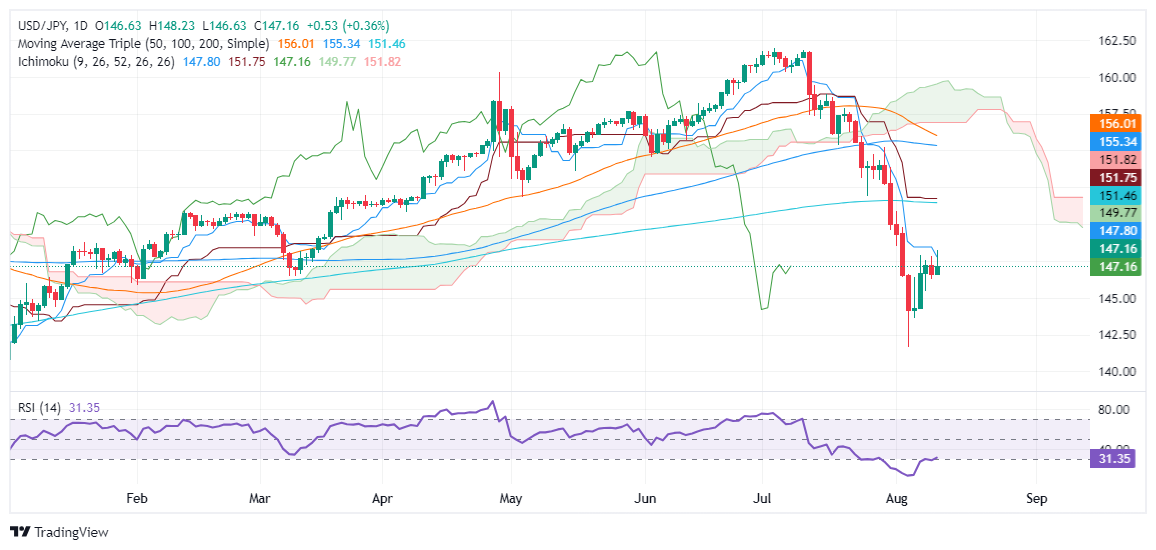- Analytics
- News and Tools
- Market News
- USD/JPY Price Forecast: Rises, yet struggles at 148.00
USD/JPY Price Forecast: Rises, yet struggles at 148.00
- USD/JPY briefly clears 148.00 before reversing, with RSI suggesting seller dominance.
- A drop below 146.27 could trigger further losses, targeting 145.44 and 144.28.
- If USD/JPY reclaims 147.79, resistance levels are at 148.00 and potentially 149.77, with the 200-DMA at 151.46 as a longer-term target.
The Japanese Yen fails to gain traction late in the North American session versus the Greenback as the USD/JPY rises from last Friday's daily low of 146.62 and trades at 147.28, up by 0.47%.
USD/JPY Price Forecast: Technical outlook
The USD/JPY is downward biased despite the uptick that saw the pair clear the 148.00 figure and hit a six-day high at 148.22 before reversing its course and tumbling below the Tenkan-Sen at 147.79.
The Relative Strength Index (RSI) remains bearish, hinting that momentum favors sellers.
The USD/JPY could extend its losses if the pair slumps past the August 9 low of 146.27. Once cleared, the next demand zone would be the August 8 low of 145.44, followed by the August 7 bottom at 144.28. Up next would be the last cycle low at 141.69.
Conversely, if USD/JPY clears the Tenkan-Sen at 147.79, this will clear the path to August’s 12 peaks of 148.00. On further strength, the pair could rally toward the Sekou Span A at 149.77 before testing the 200-day moving average (DMA) at 151.46.
USD/JPY Price Action – Daily Chart
Japanese Yen FAQs
The Japanese Yen (JPY) is one of the world’s most traded currencies. Its value is broadly determined by the performance of the Japanese economy, but more specifically by the Bank of Japan’s policy, the differential between Japanese and US bond yields, or risk sentiment among traders, among other factors.
One of the Bank of Japan’s mandates is currency control, so its moves are key for the Yen. The BoJ has directly intervened in currency markets sometimes, generally to lower the value of the Yen, although it refrains from doing it often due to political concerns of its main trading partners. The current BoJ ultra-loose monetary policy, based on massive stimulus to the economy, has caused the Yen to depreciate against its main currency peers. This process has exacerbated more recently due to an increasing policy divergence between the Bank of Japan and other main central banks, which have opted to increase interest rates sharply to fight decades-high levels of inflation.
The BoJ’s stance of sticking to ultra-loose monetary policy has led to a widening policy divergence with other central banks, particularly with the US Federal Reserve. This supports a widening of the differential between the 10-year US and Japanese bonds, which favors the US Dollar against the Japanese Yen.
The Japanese Yen is often seen as a safe-haven investment. This means that in times of market stress, investors are more likely to put their money in the Japanese currency due to its supposed reliability and stability. Turbulent times are likely to strengthen the Yen’s value against other currencies seen as more risky to invest in.
© 2000-2025. All rights reserved.
This site is managed by Teletrade D.J. LLC 2351 LLC 2022 (Euro House, Richmond Hill Road, Kingstown, VC0100, St. Vincent and the Grenadines).
The information on this website is for informational purposes only and does not constitute any investment advice.
The company does not serve or provide services to customers who are residents of the US, Canada, Iran, The Democratic People's Republic of Korea, Yemen and FATF blacklisted countries.
Making transactions on financial markets with marginal financial instruments opens up wide possibilities and allows investors who are willing to take risks to earn high profits, carrying a potentially high risk of losses at the same time. Therefore you should responsibly approach the issue of choosing the appropriate investment strategy, taking the available resources into account, before starting trading.
Use of the information: full or partial use of materials from this website must always be referenced to TeleTrade as the source of information. Use of the materials on the Internet must be accompanied by a hyperlink to teletrade.org. Automatic import of materials and information from this website is prohibited.
Please contact our PR department if you have any questions or need assistance at pr@teletrade.global.
















